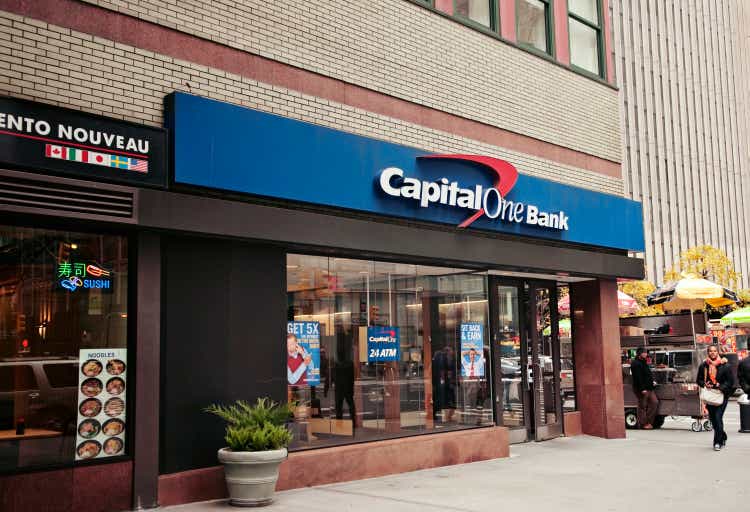Capital One’s Curious Valuation Seems To Be Predicting Tougher Times
Summary:
- Capital One’s credit metrics (auto and card NCOs and delinquencies) are still well above historical norms, though they are worsening.
- Capital One has above-average exposure to subprime customers in both cards and auto loans, but the job and wage markets are both solid.
- Card spending volumes and loan balances are likely to decelerate, as are auto loans, but mid-single-digit growth and improving spreads can still drive mid-to-high single-digit core revenue growth.
- Opex is an area where management has more work to do, as the company remains committed to growing marketing and IT spending to support the business.
- I can understand frustrations about Capital One’s “under-earnings” on higher expenses, but the valuation looks too low below the $160s unless a nasty recession is lurking around the corner.
magnez2/iStock Unreleased via Getty Images
Enlightened paranoia is a valuable asset when it comes to investing – if something looks too good to be true, it often pays to thoroughly reexamine your assumptions rather than just assume the market has it all wrong. That brings me to the curious case of Capital One (NYSE:COF). I understand concerns that charge-offs and delinquencies will get worse from here, but relative to a healthy labor market and conservative reserving, the valuation here seems to be pricing in some really tough times ahead.
Capital One came through the pandemic-driven downturn in better shape than I’d expected, and in better shape than management had expected given initial reserving decisions. The shares have risen around 90% since my last update – okay relative to large banks, about on par with American Express (AXP) and Discover (DFS), and better than Alliance Data (ADS) and Synchrony (SYF), but the shares have significantly underperformed large banks (by more than 20%) since August of 2021.
I find the valuation curious. Maybe I’m missing something, but even in the context of inflation and credit normalization, the valuation here is pretty appealing if Capital One can generate normalized core earnings growth in the neighborhood of 5%.
Not Much Concern In Credit… Yet
Capital One’s February credit update wasn’t concerning to me. Domestic card charge-offs increased again, rising 16bp month over month to 2.19%, but that’s still less than half of the long-term historical average. Likewise, delinquency rates remain well below long-term norms, with a 2.51% figure in February versus the 3.6% long-term average.
The data for the auto portfolio wasn’t alarming either, with NCOs down 45bp mom to 0.54% versus a long-term average of around 2%.
It’s certainly true that credit quality isn’t going to get better from here, but losses so far have been better than expected, and I would argue that strong employment and wage numbers are supportive of a continuation of healthy credit. Perhaps the market is down on the sector (credit card issuers, that is) because those charge-offs are going to worsen; not unlike how other sectors will sell off when investors see a cyclical decline from peak margins, if the new trough will be higher than the old one.
Capital One ended the last quarter with overall reserves of 4.21% and 7.3% reserves as a percentage of loans in the card business. That’s comfortably above CECL Day One (6.3%) and gives Capital One a buffer to absorb a faster deterioration in credit quality. What’s more, I’d again go back and note that management’s reserving assumptions got quite conservative when the pandemic hit, so I don’t believe there’s evidence that this is a bank that plays fast and loose with reserves.
It’s more than just an aside, but I’d also note that credit usage and credit card loan growth remain strong. Purchase volumes rose 29% YoY and 10% QoQ in the fourth quarter (as good as or slightly better than sector averages), with loan balances up 10% YoY and QoQ for the domestic business, and balances have continued to grow at a mid-teens rate.
Opex Concerns Seem More Valid
One area where I think there is more room to be critical is operating expenses. Even allowing for disruptions from the pandemic, Capital One is far away from management’s 42% efficiency ratio target, with a 56.3% figure in the fourth quarter.
Management continues to see opportunities to win shares in the U.S. card market, and they’re still looking to spend aggressively on marketing to target that share growth. At the same time, the company continues to reinvest heavily in its IT capabilities, with management noting that IT labor costs continue to accelerate given a shortage of competent IT professionals.
In the short term, both items are explainable and understandable. Competitive market share gains will pay off down the road, and Capital One’s IT capabilities (particularly its online/digital banking franchise) have been an important competitive asset for years. Still, it’s fair to note that Capital One’s returns (ROE, ROTE, et al) are well below the likes of AmEx, Discover, and Synchrony, and it’s not unfair to ask when the company can transition to “harvesting” the benefits of its strong market and IT position.
Growth Beyond Normalization
I don’t expect double-digit card loan growth to continue, and I do expect further normalization in credit quality. But unless there’s a recession lurking around the corner, I don’t think the earnings risk to Capital One is as large as the market seems to be suggesting.
I’m looking for loan growth to decelerate but still stay in the mid-single-digits. I’d also note that Capital One has above-average asset sensitivity, with a 100bp rate move driving a 7% or so increase in net interest income. Deposit costs and deposit beta are risks, though. Capital One has always had high funding costs and I do expect deposit betas to be higher than many expect in this next cycle. Even so, I expect a net interest margin of around 6.75% in 2023 versus 6.6% in the last quarter.
All in all, I don’t see why credit or auto loan demand should weaken beyond the mid-single-digits. I also don’t see much evidence of rivals doing anything new that would drive a significant shift in market share. Capital One is more exposed to partnerships with physical retailers than some card lenders, but I don’t think it’s a particularly significant risk factor.
The Outlook
Operating leverage is definitely an important variable, and I would like to see more progress here. It’s possible that Capital One’s business is more sensitive to ongoing marketing spending than I realize, but that would seem inconsistent with the company’s long-term performance and its success in winning co-brand business. In any case, I’m expecting ERs to stay in the mid-50%s for the foreseeable future, and better performance would be good for sentiment.
All told, I’m expecting core earnings growth of over 6% over the next five years and core growth closer to 5% over the next 10 years. I’d also note that the company should be returning meaningful amounts of capital, but there is some uncertainty on timing.
Discounting that back, I believe the shares are undervalued below the mid-$160s and priced for a healthy double-digit annualized total long-term return. Using a 9x multiple to my ’23 EPS estimate (lower than historical norms), I get a fair value in the low-$170’s, and my ’23 estimate is slightly below the current sell-side average ($19.13 versus $19.16).
The Bottom Line
Capital One shares seem to be pricing in a much worse economy and/or credit evolution than I expect. High inflation is a risk for Capital One’s subprime customer base, but I think that risk is balanced by the job market. Likewise, I’m not thrilled about the opex spending levels, but that seems factored into the price. Given all of the above, I think Capital One is a name to consider for more contrarian-minded investors.
Disclosure: I/we have no stock, option or similar derivative position in any of the companies mentioned, and no plans to initiate any such positions within the next 72 hours. I wrote this article myself, and it expresses my own opinions. I am not receiving compensation for it (other than from Seeking Alpha). I have no business relationship with any company whose stock is mentioned in this article.

